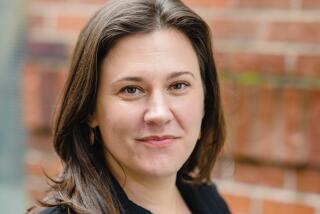Married Life, Academic Career Tough Mixture : Teachers: Tight job market means that few couples find work in the same place. Separation, commutes put strains on many families.
NEW YORK — Maria Minich Brewer and Daniel Brewer took the best job offers they got--straight to different cities. It was 14 years before they shared the same roof again for good.
“If I’d known how long it would take, I wouldn’t have done it,” said Maria Brewer, who, like her husband, teaches college French. “But I didn’t know. And that’s probably a good thing. Because it kept me in the profession.”
And there lies the curse of love in the Ivory Tower, which the influx of female professors and a tight job market have made an unlikely crucible of modern marriage.
The number of women teaching in colleges and universities rose from 12% of total faculty in 1969 to 30% in 1991, according to the American Council on Education.
With more women looking for positions in a tight job market, academics who marry each other today risk having to live apart.
“It’s endemic in the academe right now,” said Sarah Webster Goodwin, an associate English professor at Skidmore College in Saratoga Springs, N.Y. Her husband quit his job teaching Sanskrit at Brown University to reunite their family.
“I know many commuting couples,” she said. “If you have two faculty members, chances are they will not get a good job in the same place.”
That was true for the Brewers, who began their tale of two cities in 1978 when she got her job in Minneapolis. He worked five years at Cornell University in Ithaca, N.Y., before moving to UC Irvine.
The couple spent summers together, took sabbaticals, unpaid leaves--anything to bring them and their two boys, now 5 and 13, together.
Then they got lucky. In 1992, the University of Minnesota came through with a gem--tenured spots in the same field. “We just kind of thought we’d died and gone to heaven,” Daniel Brewer laughed.
Things weren’t so divine for their Minnesota colleague Tom Conley and his wife, Verena Conley. The two professors of French have been married 26 years.
“We’ve been commuting for 23 of them and we don’t like it,” Tom Conley said.
The marriage nearly fell apart at one point before Verena Conley landed a tenured job at Miami University of Ohio.
“Producing a life of value is centered on little things, like having breakfast and coffee together,” Tom Conley said. “Everything turns into a tremendously difficult event that has to be factored into this baroque schedule.
“And then the money--we’ve just been bled dry. We’re $60,000 in debt. Delta and Northwest Airlines own the rights to our bodies.”
Verena Conley went on the job market when nepotism rules limited career options for professors’ “wives.” When Tom got his job at the University of Minnesota in 1973, “he was told flat out there would be nothing for his wife,” she said.
The couple chose not to make career sacrifices.
“We could’ve been together under circumstances that would not have made one of the people very happy,” Verena Conley said. “It’s very hard when you want equal jobs.”
It was easier for schools in the 1950s, when men had regular positions and nepotism rules forced women into research posts or part-time teaching.
But circumstances--more women working, a job market that’s been shrinking since 1988 and more people getting Ph.D.s--have helped turn academia into a nuptial nightmare, said Bettina Huber, research director for the Modern Language Assn., which represents 30,000 teachers of English and foreign languages.
“We really haven’t caught up in terms of our policies with the consequences of two people being in the workplace,” said Goodwin, whose husband watches the children and is considering a career outside academia.
Most colleges and universities have abandoned nepotism rules. Some are adopting spousal-hiring policies in which they give special consideration to faculty spouses when jobs open up.
“It arises in virtually every conversation I have with a candidate,” said Reed Browning, the provost at Kenyon College in Gambier, Ohio. “And I’m not the one that brings it up.”
Kenyon, Denison University and The College of Wooster, rural Ohio schools within an hour’s drive from one another, have taken out a joint ad in the Chronicle of Higher Education seeking academic couples.
“We all face situations now that almost every position we want to fill--the person has a spouse with professional ambitions,” Browning said.
But administrators say their commitment to hiring the best person for the job makes it hard to guarantee jobs for spouses. Most faculty members would agree.
“I don’t think there should be universal pressure to hire spouses,” Goodwin said. “That would be death.”
However, there are ways to make life easier for commuter couples, such as scheduling classes and easing time-consuming committee assignments, she said.
Goodwin is writing a handbook on family policy to help administrators and faculty deal with new issues sprung from academe’s changed work force.
For commuting partners, it’s about time.
“Academic institutions eat people. Even the best of them, in terms of teaching load, build up demands that can be amazing,” Goodwin said.
More to Read
Sign up for Essential California
The most important California stories and recommendations in your inbox every morning.
You may occasionally receive promotional content from the Los Angeles Times.










